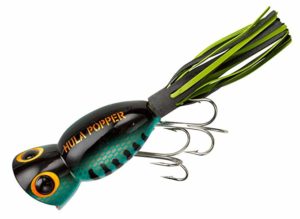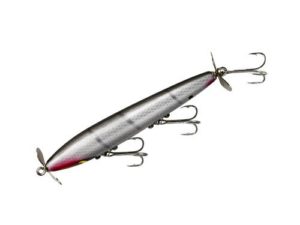The only thing sweeter to a fisherman then seeing a bass strike.

Is them jumping to try and free the hook that you have set in there mouth.
Topwater lures are known for causing this adrenaline rush and producing some great action when it comes to catching bass. Depending on the structure around where you are fishing they could be the only viable option to use to get those lunker bass.
There are tons of topwater lures out there to use, how to choose other than buying all of them and trying them. Do your homework and read the reviews, But hey below is just that. here are some of the best topwater lures to use.
Arbogast Hula Popper
The famed “Hula Popper” has been around for more than 60 years. And for good reason. Its cupped lip scoops water with a short jerk of the rod, producing a loud “bloop” that regularly triggers bass to attack. The strikes are vicious. The skirt of the Hula Popper adds flare to the visual presentation. With two exposed trebles, this isn’t a weedless bait. Fish it adjacent to lily pads, over weedtops or near other underwater structure. You can also pound shallow shorelines with the Hula Popper, as its sound and presentation will easily attract fish from a distance.
 Arbogast Jitterbug
Arbogast Jitterbug
Arbogast’s other legendary topwater is the “Jitterbug.” Unlike a popper, the Jitterbug’s double-cupped lip produces and even, rhythmic surface commotion. This lure shines brightest after dark. It’s loud call and intense vibration trigger the lateral line and hearing of nighttime bass on the prowl. And with a steady, straight retrieve, the Jitterbug is a target that bass can easily hit in the dark. This isn’t a weedless lure, so fish it around or over any structure that potentially hold fish. Bass will mostly feed in the shallows after dark, so concentrate your efforts in flats between two feet to five feet of water.
Heddon Zara Spook
If you’re going to be bass angler, you’d better know how to “walk the dog.” The seductive, (or annoying) topwater action has proven to catch fish time and again. The makers of Heddon “Zara Spook,” literally invented the action over 75 years ago. Since then, the design has been copied by dozens, if not hundreds of lures. Despite the hoard of pretenders, the original Zara Spook is still king. Fish the bait around any potential bass hideouts, making sure to vary your retrieve. Some days bass will prefer a faster walking motion, while other times it may take a slower action to trigger strikes.
Creek Chub Knuckle-Head
The “Knuckle-Head” is the other popper-style lure to make our list. With all the poppers on the market, the Knuckle-Head stands out due to its jointed body and one-of- a-kind body motion. The design is so unique that it earned a patent. In addition to the popping noise, the Knuckle-Head has a slender profile that closely resembles baitfish, and the segmented body produce a swimming action after each “pop.” The presentation replicates a wounded baitfish, complete with flared gills. The Knuckle-Head will dupe daylight bass but excels at night when bass can zero-in on its signal. The bait is also available in a “junior” model for when fish prefer a smaller profile.
Smithwick Devil’s Horse
The only “prop bait” to make our list is the Smithwick “Devil’s Horse.” Another lure that has stood the test of time, the Devil’s Horse’s double-prop churns water to create surface commotion. Its retrieve can be widely varied, from a fast buzz to a barely moving twitch to entice finicky bass. The Devil’s Horse will catch fish year-round but has earned the reputation as the Number One lure for pre-spawn largemouth. Use the Devil’s Horse to target spawning transition areas from 5- to 10-feet of water and into the shallow flats where bass bed.
